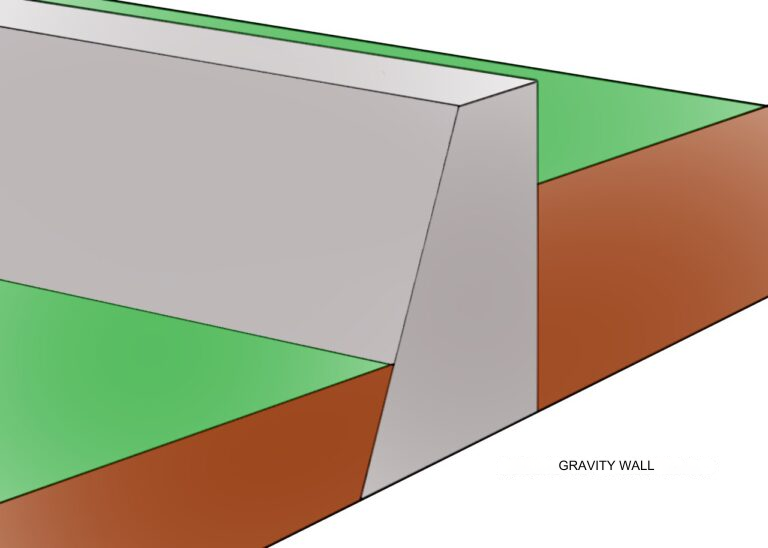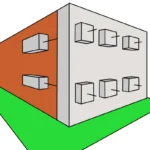What Are Retaining Walls?
Retaining walls are structures specifically designed to resist lateral forces generated by soil, water, or other materials on natural slopes or embankments. These structures play a crucial role in civil engineering and landscape management as they help prevent soil erosion, stabilize inclined terrains, and protect habitable areas and properties from hazards associated with slope inclinations.
Key Functions of Retaining Walls
Retaining walls perform essential functions in civil engineering and landscape management. Here, we delve into their key functions:
Soil Erosion Control: Retaining walls effectively guard against soil erosion. When water flows down a slope or embankment, it can carry soil particles with it, gradually eroding the surface. This not only damages the landscape but can also block nearby drains and bodies of water. Retaining walls prevent soil from being washed away, preserving the integrity of the terrain.
Slope Stabilization: In inclined terrains, slope stabilization is crucial to prevent potentially dangerous landslides. Retaining walls provide structural support that counteracts the forces of inclination and gravity. By doing so, they keep the slope in place, reducing the risk of collapses, which is vital for people’s safety and property protection.
Landscaping Design: In addition to their purely utilitarian functions, retaining walls are creatively used in landscaping design. They can create terraces in gardens, parks, and public spaces, enabling the cultivation of plants in sloped areas. These walls can be constructed with materials that harmonize seamlessly with the environment, such as stone or wood, adding aesthetic value to the landscape.
Infrastructure Protection: Retaining walls also protect critical infrastructures, such as roads, railways, and buildings, by preventing erosion that could weaken foundations or damage structures. This is especially important in areas prone to natural disasters like floods and earthquakes, where retaining walls can act as defense barriers.
Increased Land Use: In areas with steep slopes, retaining walls can enable the development of areas that would otherwise be unusable. By creating terraces or levels, these walls make the terrain more accessible and habitable, subsequently increasing property values and land utility.
Sedimentation Prevention: When eroded soil is deposited in nearby bodies of water, it can cause sedimentation. This can negatively impact water quality and aquatic habitats. Retaining walls help reduce erosion and, therefore, sedimentation, contributing to the preservation of water resources.
Maintenance Reduction: By controlling erosion and stabilizing slopes, retaining walls can reduce the need for costly long-term maintenance work. This saves time and resources for authorities responsible for infrastructure and landscape maintenance.
Components of Retaining Walls
Retaining walls can have different components depending on their design and specific type. Here are some common parts found in many retaining walls:
Foundation: The base of the retaining wall, located below ground level. The foundation distributes the weight of the wall and provides stability.
Water Toe: The bottom part of the wall in contact with the soil or water. It provides additional support and helps distribute the forces of the wall to the ground.
Core: The central or main part of the wall that provides most of the structural strength. It can be made of concrete, masonry, or other materials.
Crown: The top part of the wall, which can be wide and flat to serve as a platform, especially in gravity walls.
Front Face: This is the visible part of the wall facing the slope or the area to be retained. The front face may have an aesthetic finish, such as bricks or stone, in the case of masonry walls.
Heel or Backfill: The back part of the wall in contact with the retained soil or fill material behind the wall. In some cases, compacted fill material is used to add additional stability.
Drainage: In many retaining walls, especially those used in civil engineering applications, a drainage system is installed to channel water away from the wall and prevent the accumulation of hydrostatic pressure behind it. This may include drainage pipes, geodrains, or drainage materials.
Reinforcements: In reinforced earth retaining walls (RE walls) and other types, geotextiles, geogrids, or steel reinforcement bars can be incorporated to improve the stability and strength of the wall.
Anchors or Tiebacks: In anchored walls, anchors or tiebacks are used to provide additional reinforcement to the wall, extending from the front of the wall into the soil behind it.
These parts can vary in design and size depending on the type of retaining wall and site conditions. The choice of components and their design depends on factors such as wall height, soil type, applied loads, and desired aesthetics.

Classification of Retaining Walls
Retaining walls can be classified in various ways based on different criteria. Here is a common classification of retaining walls based on various aspects:
According to the Support Mechanism:
Gravity Walls: Supported by their own weight and resist lateral forces of the soil due to their mass. They are usually made of concrete or stone.
Cantilever Walls: Use a concrete slab or plate at the top that extends backward over the slope. They rely on the lever arm principle to resist lateral forces.
Anchored Walls: Reinforced with anchors or tiebacks extending into the soil behind the wall, transferring lateral forces to the surrounding soil.
According to the Construction Material:
Concrete Walls: Primarily made of reinforced concrete. They are strong and durable.
Masonry Walls: Use individual units such as bricks, concrete blocks, or natural stone, assembled with mortar. They are often aesthetic and popular in landscaping design.
Prefabricated Segmental Walls: Combine prefabricated concrete blocks assembled like puzzle pieces. They are versatile and easy to install.
According to Use and Application:
Reinforced Earth Walls (REW): Use earth reinforcement materials like geotextiles and geogrids to increase load-bearing capacity. Common in landscaping design.
Reinforced Gravity Walls: Combine the design of gravity walls with reinforcement materials, suitable for greater heights and challenging terrains.
Segmental Retaining Walls: Composed of prefabricated segments that adapt to various heights and terrains.
According to Application and Design:
Road Retaining Walls: Specifically designed to provide support and retention on roads and road engineering projects.
Landscaping Retaining Walls: Focus on aesthetics and are used in gardens, parks, and public areas to create terraces and spaces with slopes.
Dam Retaining Walls: Built to withstand large water loads and are often made of reinforced concrete.
Port Retaining Walls: Used in ports and coastal areas to protect infrastructures from water forces and erosion.
According to the Operating Principle:
Driven Retaining Walls: Installed by driving or pounding piles, posts, or other elements into the ground to create a retaining barrier.
Other types, such as wood retaining walls, which use this specific material for construction.
Types of Retaining Walls
The types of retaining walls vary based on their design, materials, and construction methods. Each type is designed to address specific needs and challenges in civil engineering and landscape management. Below, we delve into the most common types of retaining walls:
Gravity Walls: Gravity walls are massive and supported by their own weight. They are generally constructed with concrete or stone and leverage the material’s mass to resist lateral forces of the soil. These walls are suitable for moderate heights and are commonly used in civil engineering applications such as road and railway retaining walls.

Masonry Walls: Masonry walls are composed of individual units of brick, concrete blocks, natural stone, or similar materials. They are assembled with mortar and can take on various shapes and designs. These walls are popular in landscaping design projects and can provide an attractive aesthetic.
Cantilever Walls: Cantilever walls use a concrete slab or plate as a supporting beam at the top, extending backward over the slope. This design exploits the lever arm principle to resist lateral forces. They are effective for applications with moderate to high heights and are commonly used in embankment construction and retaining walls.

Segmented Retaining Walls: These walls consist of prefabricated concrete blocks that fit together like puzzle pieces. The segments create a solid structure that can adapt to various terrains and heights. They are versatile, easy to install, and allow for the rapid construction of stable retaining walls.
Anchored Walls: Anchored walls are reinforced with anchors or tiebacks that extend into the soil behind the wall. These anchors transfer lateral forces to the surrounding soil, allowing for the construction of thinner and taller walls. They are ideal for situations with space constraints.

Reinforced Earth Walls (REW): REW utilizes materials such as geotextiles and geogrids to reinforce the load-bearing capacity of conventional earth retaining walls. They are especially suitable when a more natural appearance is desired, and they are commonly used in landscaping applications.
Reinforced Concrete Walls: These walls are made of reinforced concrete, combining the strength of concrete with the tensile strength of steel. They are durable and resistant, making them suitable for high-load applications, including dam retaining walls and port structures.

Driven Retaining Walls: Driven walls are installed by driving or pounding pilings, posts, or other elements into the ground to create a retaining barrier. This type is ideal for areas where deep excavation is not feasible. Driven walls are suitable for limited spaces and coastal projects, requiring less excavation and minimizing environmental impact.

Counterfort Retaining Walls: Designed for areas with steep slopes, these walls consist of a vertical wall backed by counterforts or inclined supports extending into the slope. These counterforts help distribute the weight and lateral forces of the soil, allowing for the construction of taller and more robust walls. Counterfort retaining walls are suitable for mountainous terrains and can be used in civil engineering and landscaping applications.
Differences in Each Type of Retaining Wall
The differences between the types of retaining walls lie in their design, materials, and construction methods, and these differences determine their suitability for specific applications. Here are some key differences between the mentioned types of retaining walls:
Gravity Walls:
Operating Principle: Supported by their own weight and resist lateral forces through the mass of the material.
Materials: Concrete or stone.
Common Applications: Roads, railways, civil engineering applications.
Masonry Walls:
Operating Principle: Use individual units of brick, concrete blocks, or other materials assembled with mortar.
Materials: Bricks, concrete blocks, stone.
Common Applications: Landscaping design, decorative walls.
Segmented Retaining Walls:
Operating Principle: Prefabricated blocks assembled like puzzle pieces.
Materials: Concrete blocks.
Common Applications: Garden walls, landscaping retaining walls.
Reinforced Earth Walls (REW):
Operating Principle: Use earth reinforcement materials such as geotextiles and geogrids.
Materials: Geotextiles, geogrids.
Common Applications: Landscaping design, retaining walls in natural areas.
Cantilever Walls:
Operating Principle: Use a concrete slab or plate extending backward over the slope.
Materials:
Common Applications: Embankments, retaining walls.
Anchored Walls:
Operating Principle: Reinforced with anchors or tiebacks extending into the soil behind the wall.
Materials: Concrete, steel.
Common Applications: Limited space walls, taller walls.
Reinforced Concrete Walls:
Operating Principle: Use reinforced concrete with steel bars.
Materials: Concrete, steel.
Common Applications: Dams, port structures, high-load applications.
Driven Retaining Walls:
Operating Principle: Installed by driving or pounding elements into the ground.
Materials: Steel piles, concrete, or wood.
Common Applications: Limited space areas, coastal projects.
Counterfort Retaining Walls:
Operating Principle: Rely on counterforts or external supports.
Materials: Concrete, masonry, or concrete blocks.
Common Applications: Steep slopes, civil engineering, landscaping.
Conclusion
Retaining walls play a fundamental and versatile role in civil engineering and landscape management. Their impact extends beyond simple soil retention, significantly contributing to the safety, aesthetics, and sustainability of the areas where they are implemented. Choosing the right type of retaining wall is essential, as differences in how they resist lateral forces, the materials used, typical applications, and specific advantages can influence the project’s success. These variations underscore the importance of carefully considering project needs, site conditions, and aesthetic goals when selecting the most suitable type of retaining wall for a specific application.







Related
Gravity Retaining Walls
What are Anchored Retaining Walls?
Methods for Paver Calculation – Civil Engineering